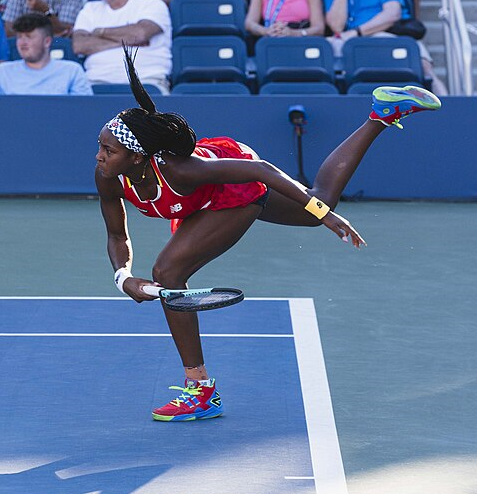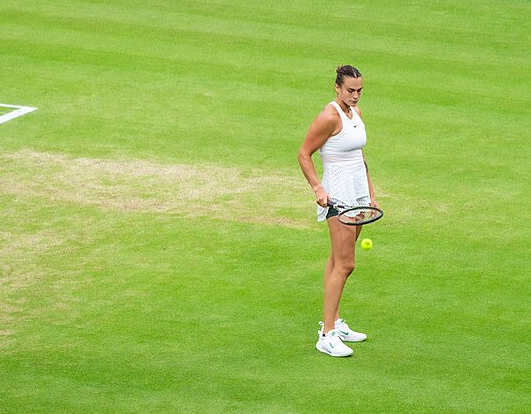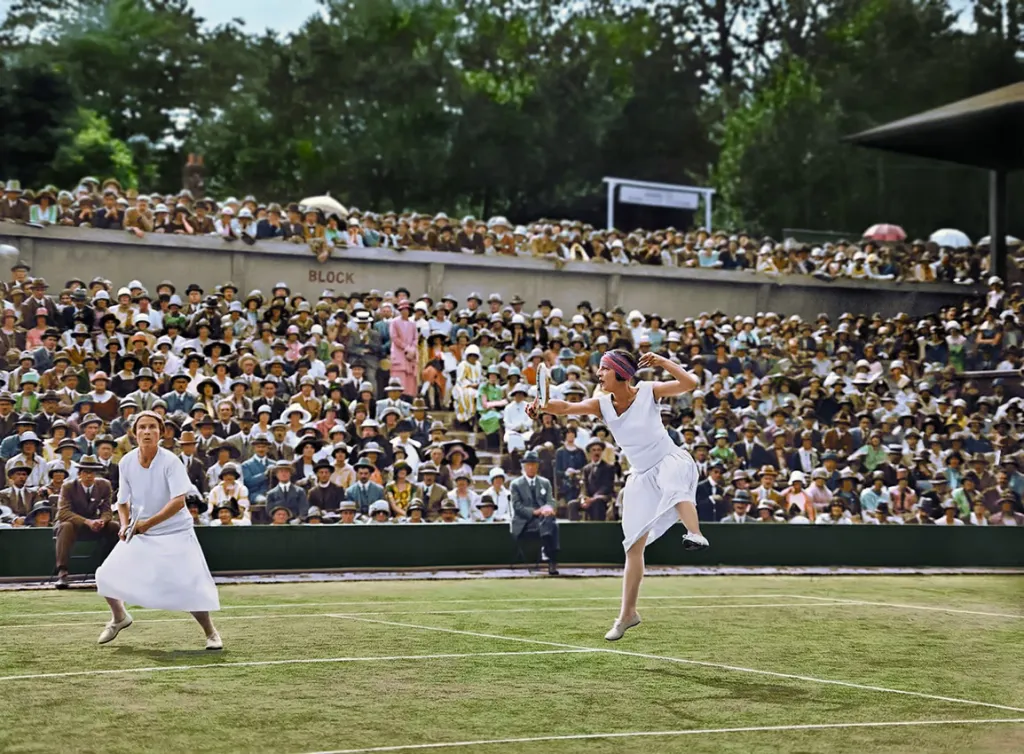
The best players are able to work around their weaknesses. Coco Gauff is so solid that she has overcome two: an unreliable forehand and a second serve that hands too many points to her opponents. On Wednesday in Wuhan, Gauff coughed up 5 double faults out of 19 second serves. Despite surrendering more than 10% of her serve points for the fifth consecutive match, she eased past Viktoriya Tomova. The Bulgarian managed just three games.
The forehand is a subject for another day. Lately, the serve has been a bigger concern, the one blot on an eight-match win streak (and counting) in China.
Start with season totals. Through last week’s Beijing final, Gauff has missed more than one in five of her second serves. The result: She has double-faulted 8.9% of her 2024 service points. No other woman in the WTA top 60 has double faulted so often.
The typical tour regular loses barely half so many points this way. Tour average is 5.1%. Fellow elites Iga Swiatek, Jessica Pegula, and Jasmine Paolini come in at 3% or lower; Emma Navarro just misses that mark at 3.1%. Even Aryna Sabalenka, with her recurring bouts of service shakiness and occasional risk-taking on the second serve, gives away only 4.5% of points.
Still, Coco rates as the fourth-best player in the world. She’ll be back to #3 on Monday, and she has a good chance of ending the season there. The rest of her game is so sturdy that she has piled up nearly 50 wins on the season despite committing 274 more double faults than Swiatek has.
This is uncharted territory. In the last 15 years–the extent of my serve stats for women’s tennis–only two players have hit double faults so often and still managed to finish in the top five. No one has cracked the top three:
DF Rate Player Year Rank 10.4% Aryna Sabalenka 2022 5 9.6% Maria Sharapova 2011 4 8.9% Coco Gauff 2024 ? 8.7% Elena Dementieva 2009 5 8.4% Maria Sharapova 2015 4 8.1% Dinara Safina 2008 3 7.9% Dinara Safina 2009 2 7.9% Maria Sharapova 2014 2 7.9% Karolina Pliskova 2021 4 7.6% Victoria Azarenka 2013 2 7.6% Aryna Sabalenka 2021 2 7.5% Maria Sharapova 2013 4 7.3% Maria Sharapova 2012 2 7.0% Venus Williams 2010 5
The typical year-end number one double faults only 4.1% of the time. Victoria Azarenka’s 2012 season, at 6.8%, was the only such occasion over 6%. This isn’t exactly a law of physics, but if Gauff is to dislodge the two women atop her in the ranking table, she’ll probably need to make a substantial move in that direction.
What-ifs
It’s no easy task to fix a leaky serve. The good news for Coco is that it may be all she needs to do.
Back to the season totals. Gauff is basically tied with Swiatek as the best returner in the game. The American has won 48.4% of her return points this year, compared to Iga’s 48.5%. Gauff has played slightly weaker opposition, but in any case, it’s a minor gap. Both women stand well above the pack; no one else tops 47.5%. With no double faults working against her, Coco’s return game is worthy of a world number one.
By service points won–where the double faults come into play–Gauff ranks a more pedestrian 12th. That’s entirely because of the deliveries that miss. She wins more first-serve points than anyone except for Qinwen Zheng and Elena Rybakina. In an era without megastars, the combination of 1st or 2nd on return and 12th on serve might be good enough to lead the field, but with an all-rounder like Swiatek and a dominant slugger like Sabalenka to contend with, it doesn’t do the job.
Here, then, is the what-if. Wave a magic wand and proclaim that all of Gauff’s second serves find the box. The 9% of her service points that end in double faults turn into second serves in play: points that she wins at a 56% clip.
Do that, and her rate of serve points won–currently at 60.2%, good for 12th place–becomes 65.3%, better than anybody. A double-fault-free Coco Gauff would rack up more serve points than anyone on tour, while still winning almost as many return points as Iga does. A handful of key points might swing the year-end number one in either direction, but statistically, the American would be the best player in the world.
You might argue that even in the rosiest real-life scenario, Coco isn’t going to eliminate double faults entirely. Fair enough. Reduce her double fault rate to tour average, and she wins 62.5% of service points. Not as good as Swiatek, Sabalenka, or Rybakina (or, technically, Lulu Sun in her limited tour-level action), but ahead of everybody else.
Combine serve and return into total points won (TPW%), and we see how these wishful adjustments move Gauff clear of the field–or, at least, everyone except for Iga:
TPW% Player 56.9% Coco Gauff (no dfs) 56.5% Iga Swiatek 55.4% Coco Gauff (avg dfs) 54.3% Coco Gauff (actual) 54.3% Aryna Sabalenka 53.7% Elena Rybakina 53.1% Karolina Muchova 52.9% Qinwen Zheng 52.8% Danielle Collins 52.7% Mirra Andreeva 52.6% Jessica Pegula 52.3% Victoria Azarenka 52.3% Maria Sakkari 52.3% Paula Badosa 52.1% Madison Keys 52.0% Jasmine Paolini
Actual-Coco is already near the top of the list. Take away all or half of her double faults, and at the very least she looks stronger than Sabalenka and Rybakina.
The specifics
This may seem a bit too abstract, especially since the total-points-won list has so many differences from the official ranking table. Greatness is not measured by points, but by titles, and some trophies count much more than others.
Remember that these points we’re changing took place in real–often close–matches. Reversing just a few of the double faults would have tipped the scales in Gauff’s direction. In the counterfactual, she probably didn’t lose 15 matches this year. She likely picked up more than two titles.
Take the most painful loss of the season: Coco’s fourth round defeat at the US Open. Against Emma Navarro, she committed a gut-wrenching 19 double faults. Despite that, she won 46.8% of total points. All else equal, had she landed those 19 second serves, Gauff would have almost exactly flipped the tally, winning 53.0% of points. Even with a tour-average double fault rate, she would have won 51.0% of points and–barring bad luck or a ill-timed choke–earned a victory.
Run the same exercise for the American’s other defeats this year, and we see just how strong her season could have been. If we reduce her double faults to a tour-average 5.1%, 4 of her 15 losses probably would have gone her way. Two more matches would have ended within a point of 50/50, safely in the range where a clutch (or lucky) break point or two can reverse the result.
Cut out double faults entirely, and Gauff wins at least 50.8% of points in six of the losses. She would have cleared 48% in four more, putting those in the range where luck could hand her the victory.
Even in the more conservative scenario, Gauff’s campaign looks quite different. Instead of losing to Anna Kalinskaya in the Dubai quarters, she would have faced off with Iga in the semi-finals. She wouldn’t have lost to Marta Kostyuk in Stuttgart: She’d have played Marketa Vondrousova for a place in the final. In Madrid, she would have handily beaten Madison Keys, earning a quarter-final date with Ons Jabeur. Flip the Navarro result in New York, and Coco could well have defended her US Open title.
Today’s action in Wuhan offered a glimpse of a sturdier future. Gauff cast aside Kostyuk with nary a double fault, advancing to the quarters in just 61 minutes. It was her quickest match since April–against an opponent who has bedeviled her in the past–and her first double-fault-free outing in 14 months.
The American has somehow established herself as a top-five player and grand slam champion despite handing her opponents more free points than any of her peers. A stingier Coco Gauff could soon be the best player in the world.
* * *
Subscribe to the blog to receive each new post by email:

